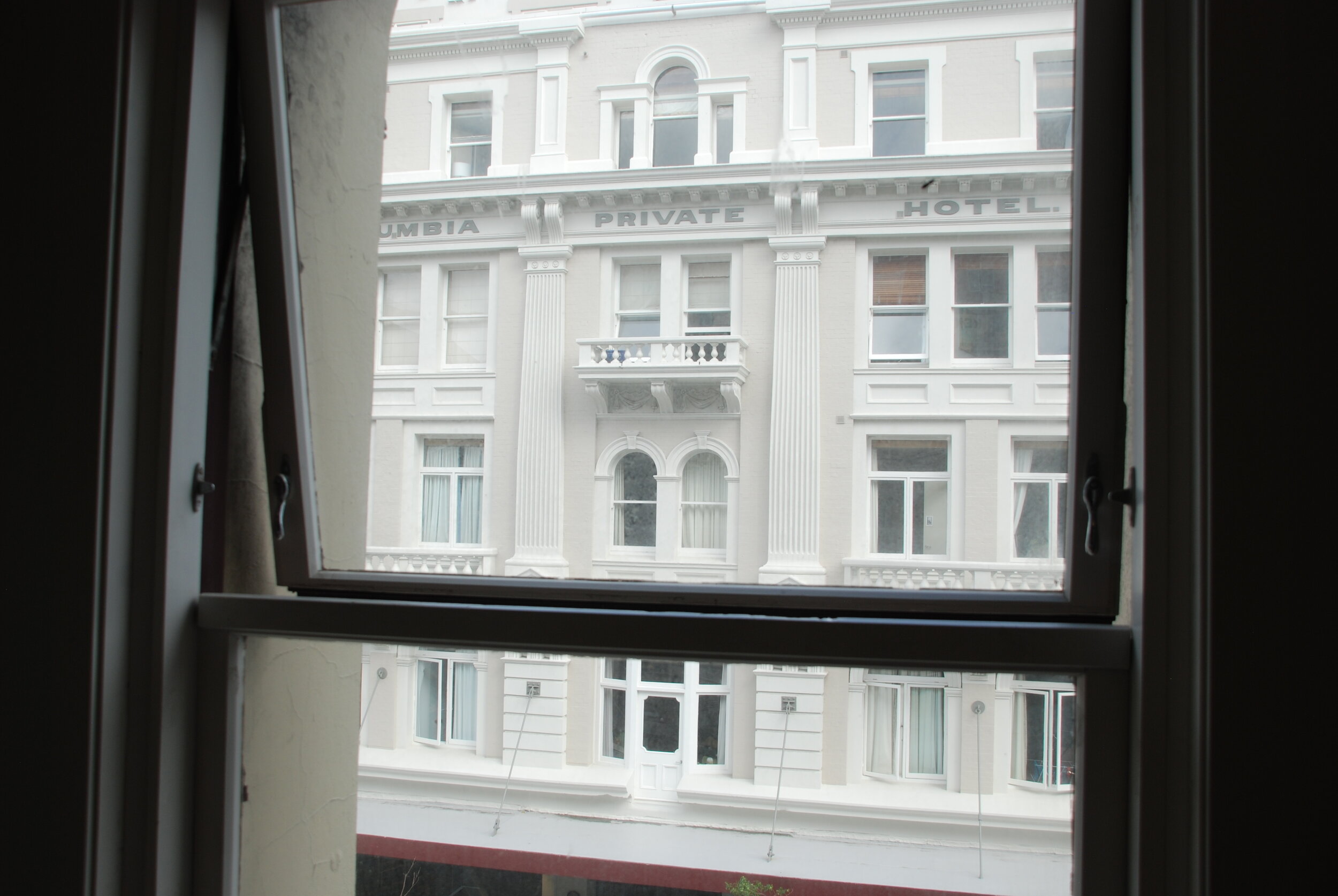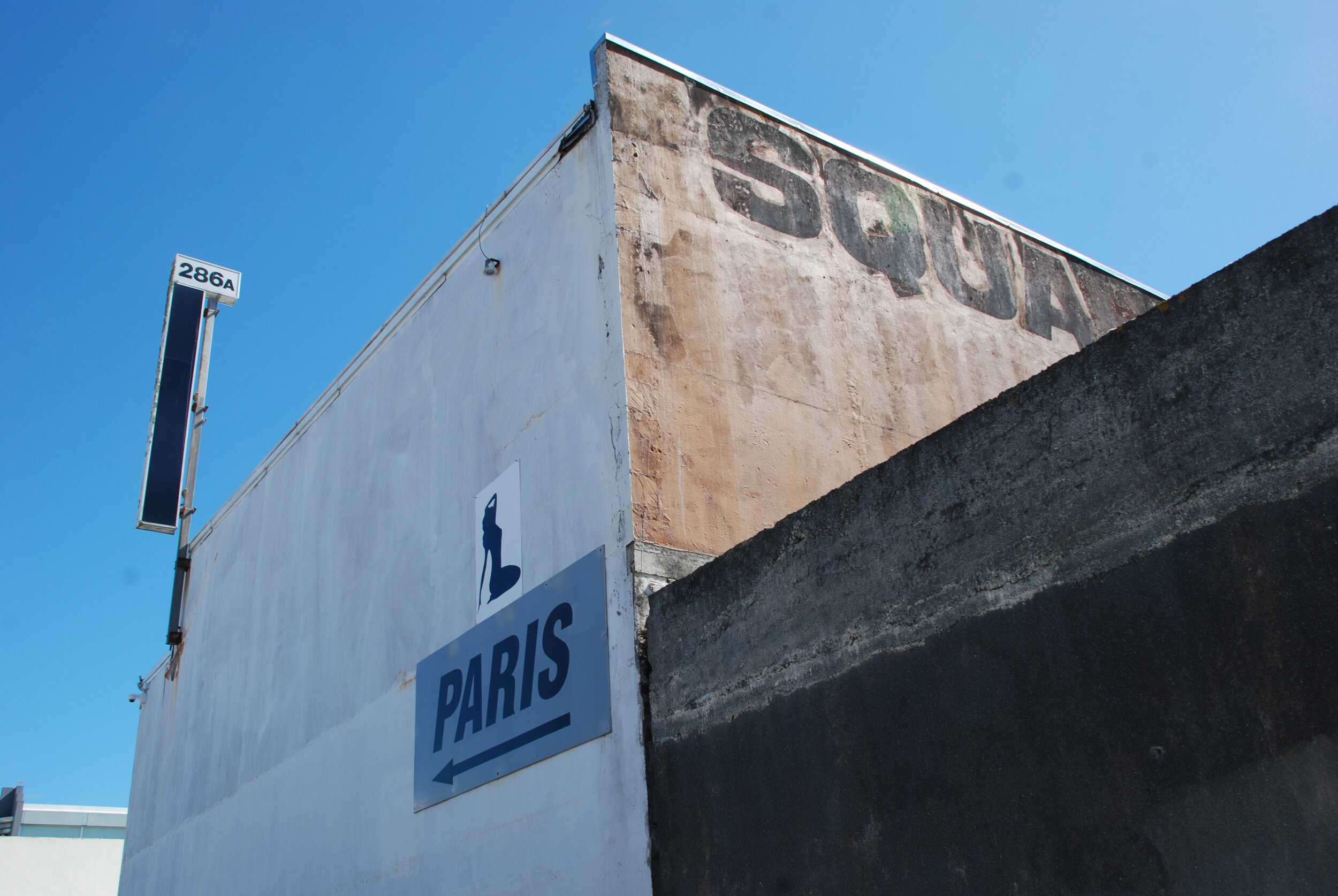Madeleine Slavick - featured portfolio
My Body, My Business
New Zealand sex workers in an era of change, Caren Wilton, photographs by Madeleine Slavick
Otago University Press, 2018
Response by Janet Bayly for PhotoForum
Madeleine Slavick, Columbia Private Hotel, Wellington, previously Lloyds, where during World War II proprietor Clara 'Ma' Hallam rented rooms by the hour to US servicemen and sex workers.
Oral historian, writer and editor Caren Wilton writes in her introduction, ' I have often thought of the world of sex work as a world apart, a separate, secret work that can only be entered by those who - as in a fairytale - have been given the special key, or who know or utter a secret word. And then the walls dissolve, the curtains are pulled back, and the secret world is revealed as not so secret after all, as just another part of this world, just a breath or a step away'.
Caren Wilton conducted extensive interviews over nearly eight years with sex workers and former workers about the sex industry and their lives in and out of it, 11 of which were ultimately published here. ‘I wanted to make visible the invisible, to bring the hidden into the light, at least a little bit, and to record a time and some places and ways of being that had existed but were now mostly gone.’
The engrossing and powerful interviews are accompanied by 16 photographs commissioned from poet and photographer Madeleine Slavick. Now based in the Wairarapa, Madeleine Slavick has lived in the United States for 25 years and Hong Kong for 25 years. Four photographs from San Francisco, Hong Kong, New Mexico and Rio de Janiero were included in the final selection for publication.
Madeleine Slavick, Woman in a lift lobby, Hong Kong.
The word secret is pivotal, as the world of sex work has been a 'largely invisible, veiled world' where discretion and privacy, for both the workers and their clients - as well as the personal and legal dangers of working in it prior to its decriminalisation in 2003 - have historically been part of its character. There is a tension here in making visible the invisible, and the way Madeleine Slavick’s photographs are located - poised on the transitional space between these two worlds - or is it, between ways of seeing (in a post-Berger world).
'Allan' describes the change from when he started sex work in his teens and returned to it in his forties, after the law changed: 'you're not having to work under this of darkness and seediness, actually it can be done in a place of light.’
As stress, subterfuge, illegality and sometimes danger were part of the context of sex work in the 60-plus years this book spans prior to 2003, an element of that is overlaid on the photographs of some of the sites associated with sex work. Despite the new openness since decriminalisation, Caren Wilton notes that only three of the interviewees appear under their full name, 'a clear illustration of the continuing stigmatisation of sex work ...'
Madeleine Slavick, Interior, Paris, Lower Hutt.
There is a second element that Caren Wilton describes as a conundrum around the power of visual representation which impacted on the photographs Madeleine Slavick could make. Including their portraits would have given those interviewees potentially greater prominence and vividness than those who were not photographed. Aside from the named interviewees, most of the sex workers 'were strongly committed to remaining anonymous, and did not want their faces to appear in the book.' So alongside the context of greater openness and a new legality to their work, Madeline Slavick remained limited to 'photographing sites that are, or historically have been, associated with the sex industry or with sex-worker activism.' These sites are front-loaded to represent the wider context to the individual stories that form the solid core of the book.
The decision was clearly made, then, for photographs that alluded to, rather than literally depicted, sex workers. This marks a departure from earlier documentary photo-essays by Mary Ellen Mark (Falkland Road, Bombay, India, 1978) and Ans Westra, (Behind the Curtain: Photographs of the sex industry, 2000). While not an extended photo-essay in the same way, Slavick's images need to stand on their own within the larger setting of the book, while being very coherent with its sensitive human context. As a writer and poet herself, Madeleine Slavick has a heightened sensitivity to the close relationship between text and image, image and text. [1] The images add another layer of storytelling and interest to the wider project. I did wonder however why the international photographs were included given this relatively small selection to represent local stories. Perhaps it was because they can also act allusively and the stories of sex-workers also belongs to the wider world.
Madeleine Slavick, Sex worker mural painted by Michael Ting and Michael Bensemann in 1990, Bicycle Junction, Marion Street, Wellington.
Caren Wilton quotes oral historian Anna Green 'we explain our lives as stories... Remembering is a complex process .... Memories are partial and fragmented, and in the process of reassembling them for others we decide what to include or exclude. We also seek to make meaningful connections between the present and the past.' The tools of selection, framing and editing are also important to the ways photographs can create meaning or narrative. Given the various constraints around the photographs here, they needed to be able to work more allusively to suggest an experience without literally picturing it or its participants. The other challenge Madeleine Slavick had to negotiate was the clichés historically associated with the sex industry.
Caren Wilton's selection of people aimed to represent sex work across genders, ethnicities, class backgrounds, sexual orientations, locations and eras. The stories that were ultimately published however were simply ‘great stories' from lively and vivid story-tellers. This also set a high bar for the photographs as the visual introduction to each chapter. Caren Wilton was attracted to Madeleine Slavick's 'luminous, reflective and multilayered photographs' which she felt would complement the 'layered, complex and sometimes veiled and secretive nature' of the sex industry. I agree that Madeleine Slavick's photographs when seen in their ideal form as original prints or an audiovisual presentation have all of those qualities. The softening effect of the matt printed page has however considerably muffled the layered visual complexity of these images. They have become shorthand ciphers for settings, some of which read better than others.
Photographs such as Columbia Private Hotel, Wellington, previously Lloyds, where during World War II proprietor Clara 'Ma' Hallam rented rooms by the hour to US servicemen and sex workers allow a more nuanced reading. Exterior scenes also work better, such as Sex worker mural painted by Michael Ting and Michael Bensemann in 1990, Bicycle Junction, Marion Street, Wellington which has a welcome touch of humour and human presence. By contrast the gloomy Dungeon, MM Club, Wellington is largely lost on the page and does not match the lively intelligence of Mistress Margaret with her wonderful insights into this scene, while the luscious cover image from the same setting has lost its plumped-up pillows.
Madeleine Slavick, Car and Home New Mexico.
Car and home, New Mexico is a more allusive image of light and shade playing over a parked car and windowed facade which delivers the complex layers and multiple perspectives that Madeleine Slavick is attracted to. It rhymes well with the sad but ultimately rich life-story told by 'Allan'. Another visually complex exterior Carmen Rupe cross-light, Cuba Street, Wellington references this much loved Wellington personality in what should be a strong image. A trail-blazing transgender entertainer and celebrated LGBTIQ+ icon, both Carmen Rupe and her setting have lost most of their subtle richness in this reproduction.
The simpler architectural images work better, such as Exterior, Paris, Lower Hutt. The glamour and sophistication of Paris could not be more bluntly contradicted by the ugly wall and its kneeling woman in silhouette. The interior Ceiling Light, Paris, Lower Hutt is more difficult as it joins the store of visual tropes that have traditionally signified sex work - red-and-gold lighting, chiffon curtains, stiletto heels and lacy lingerie, evident in other images here too.
Madeleine Slavick, Exterior, Paris, Lower Hutt. The building was previously a squash club and sauna.
Having felt privileged to read the fascinating, moving and terrifying stories of these sex workers, and despite the stripped-down presence of Madeleine Slavick's photographs in reproduction, I find they have a surprising coherence of feeling with the 'partial and fragmented' sense of the stories. Is it perhaps because people are not visually present in them? Was it because I imagined or have seen some of the settings largely as they appear? Or that the visual stereotypes are actually quite representative of some of the fixed physical locations that sex-workers have operated in? Or finally am I, like the sex workers interviewed, bringing my own imagination to this recreated history, personally inflected as this always is. I think it is also because Madeleine Slavick has been able to locate herself in the settings and been patient enough to wait for some light to reveal enough of the bones (and heart) of the stories that they hold. She has stated, "In the projects I undertake, I try to create a sense of community which enriches me, the other participants, and the audience." This book is a rich record of an important part of our recent cultural history.
Madeleine Slavick, Carmen Rupe cross-light, Cuba Street, Wellington. Pedestrian traffic lights featuring Carmen were installed at a number of Cuba Street intersections in 2016.
Janet Bayly is currently director curator of Mahara Gallery, which is the district gallery for the Kapiti Coast. She has been a photographer, editor, curator, writer and teacher of photographic histories since graduating with a Master of Fine Arts from Elam School of Fine Arts, University of Auckland, in 1980.
Footnote
[1] Madeleine Slavick has authored several books of poetry, photography and non-fiction: ‘Round - Poems and Photographs of Asia’ (1998), ‘Delicate Access’ (2004), ‘My Favourite Thing’ (2005), ‘Something Beautiful Might Happen’ (2010) and ‘50 Stories 50 images’ (2012). She has exhibited her photography and performed her poetry in several countries and lives in the Wairarapa, where she undertakes various writing, editing, photography and community projects.







